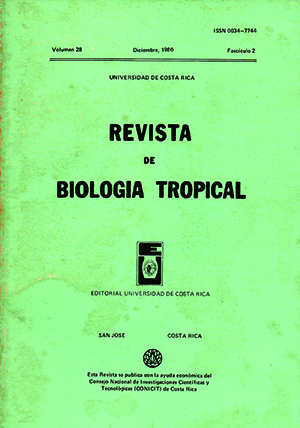Resumen
Se estudiaron comparativamente los venenos de ejemplares recién nacidas (menos de un mes de edad) y adultas de Bothrops asper de dos regiones costarricenses: San Carlos en la vertiente atlántica y Puriscal en la pacífica. La comparación se basó en la determinación de los efectos hemorrágico, mionecrótico, edematizante, proteolítico, hemolítico y letal, así como la neutralización del efecto letal por suero antiofídico polivalente; además se efectuó una comparación bioquímica e inmunoquímica mediante electroforesis, inmunoelectroforesis e inmunodifusión en dos dimensiones. Los venenos de ejemplares recién nacidos y adultos de ambas regiones mostraron marcadas diferencias entre sí en lo que respecta a los patrones electroforético e inmunoelectroforético, aunque la inmunodifusión mostró una identidad casi completa. Los venenos de recién nacidas de ambas poblaciones son más proteolíticos, más hemorrágicos, más edematizantes y letales, en tanto que los venenos de adultos son más hemolíticos y más mionecróticos, provocando un cuadro histológico de intensa necrosis miolítica. La letalidad de los 4 venenos fue neutralizada con título similar por el suero antiofídico polivalente.
Por otra parte, al comparar los venenos de especímenes adultos de ambas zonas entre sí, se apreció una ligera variación en el patrón inmunoelectroforético y una identidad total en la inmunodifusión. Los de San Carlos fueron más hemorrágicos y más mionecróticos, en tanto que los de Puriscal fueron más proteolíticos, siendo similares las magnitudes de los efectos letal, edematizante y hemolítico. Las mismas diferencias fueron observadas cuando se compararon los venenos de serpientes recién nacidas de ambas poblaciones entre sí.
Citas
Aragón, F., & F. Gubensek. 1979. Bothrops asper venom from the Atlantic and Pacific coasts of Costa Rica. Toxicon, 17 (Suppl. 1): 3 (Abstr.).
Bolaños, R. 1972. Toxicity of Costa Rican snake venoms for the white mouse. Amer. J. Trop. Med. Hyg., 21: 360-363.
Crowle, AJ. 1961. Immunodifussion. Academic Press, Londres 265 p.
Fiero, M.K., M.W. Seifert, T.J. Weaver, & C.A. Bonilla 1972. Comparative study of juvenile and adult prairie rattlesnake (Crotalus viridis viridis) venoms. Toxicon, 10: 81-82.
Friedrich, C., & A.T. Tu. 1971. Role of metals in snake venoms for hemorrhagic, esterase, and proteolytic activities. Bioch. Pharm., 20: 1549-1556.
Gómez-Leiva, M.A. 1975. Efecto del veneno de serpientes sobre diferentes tipos de glóbulos rojos. Tesis de grado. Universidad de Costa Rica.
Gutiérrez, J .M., & R. Bolaños. 1980 El problema de los efectos hemorrágico y mionecrótico por mordeduras de serpientes en el continente americano. Bol. Of. San. Panamer. (en prensa).
Gutiérrez, J .M., & F. Chaves 1980. Efectos proteolítico, hemorrágico y mionecrótico de los venenos de serpientes costarricenses de los géneros Bothrops, Crotalu s y Lach esis. Toxicon (en prensa).
Gutiérrez, J.M., O. Arroyo, & R. Bolaños. 1980. Mionecrosis, hemorragia y edema inducidos por el veneno de Bothrops asper en ratón blanco. Toxicon (en prensa).
Homma, M., & A.T. Tu 1971. Morphology of local tissue damage in experimental snake enve nomation. Br. J. Exp. Path., 52: 538-542.
Jiménez-Porras, J.M. 1964a. Venom proteins of the fer-de-lance, Bothrops atrox from Costa Rica. Toxicon, 2: 155-166.
Jiménez-Porras, J.M. 1964b. Intraspecific variations in composition of venom of the jumping viper, Bothrops nummifer. Toxicon, 2: 187-195.
Jiménez, E., & I. García 1969. Análisis de 86 casos de ofidismo en niños. Rev. Med. Hosp. Nal. Niños, 4: 91-99.
Kondo, H., S. Kondo, I. Ibezawa, R. Murata, & A. Ohsaka. 1960. Studies of the quantitative method for the determination of hemorrhagic activity of Habu snake venom. Japan J. Med. Sci. Biol., 13: 43-51.
Minton, S.A. 1967. Observations on toxicity and antigenic make up of venoms from juvenile snakes, p. 531- 562. In F.E. Russell & P.R. Sanders (eds.). Animal Toxins. Pergamon Press, Oxford.
Reid, H.A., & R.O. Theakston 1978. Changes in coagulation effects by venoms of Crolalus alrox as snakes age. Amer. J. Trop. Med. Hyg., 27: 1053-1057.
Rosenfeld, G. 1971. Symptomatology, Pathology and Treatment of snake bites in South America, p. 345. In W. Bücherl & E. Buckley (eds.). Venomous Animals and their Venoms. Vol. II. Venomous Vertebrates. Academic Press. New York.
Sass, J.K. 1979. Snake bite in the Canal Zone: an update review of cases from September 1975 to August 1978. Lab. Med., 10: 77-79.
Yamakawa, M., M. Nozaki, & Z. Hokama 1976. Fractionation of Sakishima-Habu (Trimeresurus elegans) venom and lethal, hemorrhagic, and edema forming activities of the fractions, p. 97-109. In A. Ohsaka, K. Hayashi y Y. Sawai (eds.). Animal, plant and microbial toxins, Vol. 1, Biochemistry. Plenum Press, New York.
##plugins.facebook.comentarios##

Esta obra está bajo una licencia internacional Creative Commons Atribución 4.0.
Derechos de autor 1980 Revista de Biología Tropical


